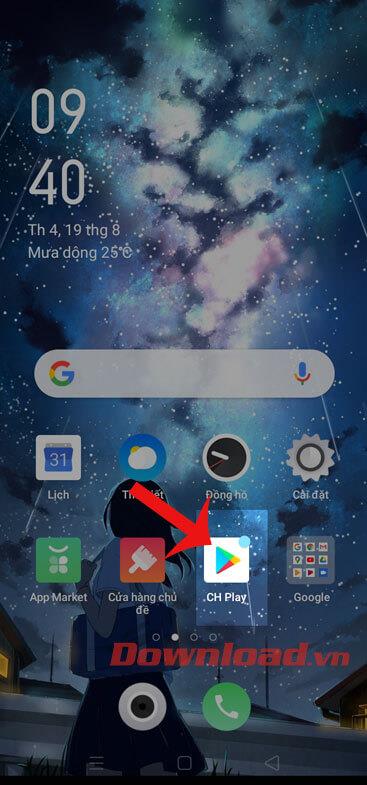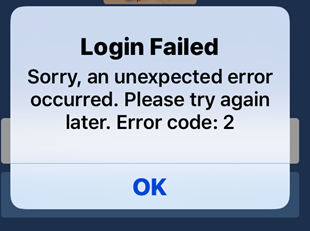How to pin comments on TikTok

How to pin comments on TikTok, TikTok allows users to pin comments easily. Here's how to pin comments on TikTok videos.
Previously, RAID technology only appeared on mainframe systems, workstations, and servers. At the present time, RAID has become a common component on regular desktop computers. However, not everyone knows how to use RAID technology effectively, even though BMC can integrate it. This article will introduce the basics of RAID as well as some experiences to use to increase the power of your desktop.
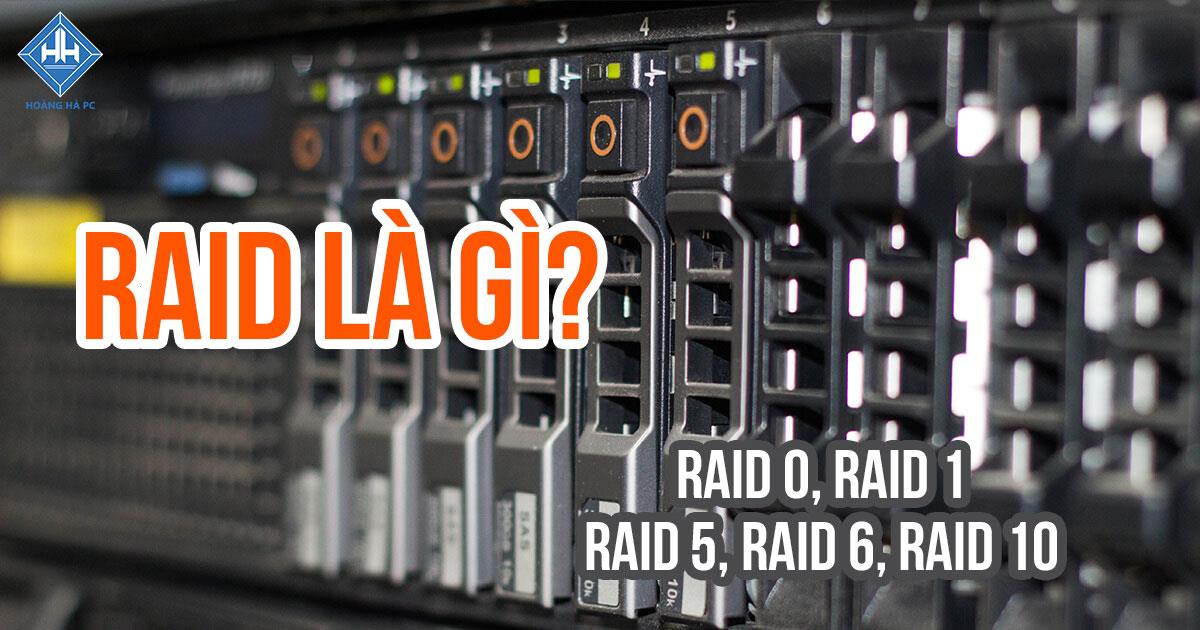
RAID stands for Redundant Array of Independent Disks, which was originally used as a data protection solution by allowing data to be written to multiple hard disks at the same time. Later, RAID has developed many different variations to ensure safety and speed up data retrieval from the hard disk. Here are five common RAID types that we can learn about.
To understand RAID quickly, we can refer to the information below:
- RAID should use hard drives of equal capacity.
- Using RAID will cost more hard drives than not using, but in return data will be better protected.
- RAID can work on many operating systems such as Windows 98, Windows 2000, Windows XP, Windows 10, Windows Server 2016, MAC OS X, Linux,...
- RAID 0 will have a capacity equal to the total capacity of the hard drives.
- RAID 1 will maintain the capacity of a hard drive.
- RAID 5 will have a smaller capacity than one hard drive (for example, using 5 hard drives RAID 5 will have the same capacity as 4 hard drives).
- RAID 6 will have less capacity than two hard drives (for example, using 5 hard drives RAID 6 will have the same capacity as 3 hard drives).
- RAID 10 can only be created when using an even number of hard drives and a minimum of four hard drives. The capacity of RAID 10 is half of the total capacity of the hard drives used (for example, using 10 RAID 10 hard drives will have the same capacity as 5 hard drives).
For example:
With a 1TB hard drive, the following RAID options are available:
- If there are 2 hard drives: Choose RAID 0 to increase the storage capacity to 2TB, but if one of the 2 hard drives fails, the data will be lost. If you try to remove a hard drive, the system will immediately report an error.
- If there are 2 hard drives: Choose RAID 1 to ensure data safety in case 1 of 2 hard drives fails. Total storage will be 1TB. If you try to unplug a hard drive, the data is still protected.
- If there are 3 hard drives: Choose RAID 1 to ensure data safety in case 2 out of 3 hard drives fail. Total storage will be 1TB. If you try to unplug the two hard drives, the data is still protected.
- If there are 3 hard drives: Choose RAID 5 to ensure data safety in case 1 of 3 hard drives fails. Total storage will be 2TB. If you try to unplug a hard drive, the data is still protected.
- If there are 4 hard drives: Choose RAID 5 to ensure data safety in case 1 out of 4 hard drives fails. Total storage will be 3TB. If you try to unplug a hard drive, the data is still protected.
- If there are 4 hard drives: Choose RAID 6 to ensure data safety in case 2 out of 4 hard drives fail. Total storage will be 2TB. If you try to unplug the two hard drives, the data is still protected.
- If there are 4 hard drives: Choose RAID 10 to ensure data safety in case 2 drives belonging to 2 different RAID pairs fail. Total storage will be 2TB. If you try to unplug a hard drive, the data is still protected.
- If there are 5 hard drives: Choose RAID 5 to ensure data safety in case 1 of 5 hard drives fails. Total storage will be 4TB. If you try to unplug a hard drive, the data is still protected.
- If there are 5 hard drives: Choose RAID 6 to ensure data safety in case 2 out of 5 hard drives fail. Total storage will be 3TB. If you try to unplug a hard drive, the data is still protected.
- If there are 6 hard drives: Choose RAID 5 to ensure data safety in case 1 of 6 hard drives fails. Total storage will be 5TB. If you try to unplug the two hard drives, the data is still protected.
- If there are 6 hard drives: Choose RAID 6 to ensure data safety in case 2 out of 6 hard drives fail. Total storage will be 4TB. If you try to unplug the two hard drives, the data is still protected.
- If there are 6 hard drives: Choose RAID10 to ensure data safety in case 2 drives belonging to 2 different RAID pairs are damaged. Total storage will be 3TB. If you try to unplug a hard drive, the data is still protected,...
To test the stability of RAID , you can perform RAID installation and Window (or Linux) operating system. After completing the installation, remove a hard drive and check if the operating system is still working properly or reporting errors.
Currently, there are many types of RAID in use such as RAID 0, RAID 1, RAID 3, RAID 4, RAID 5, RAID 10 and many others. In this article, we will introduce you to the common and commonly used RAID types.
RAID 0 is the most preferred type of RAID today due to improving the data exchange performance of the hard drive. Requires a minimum of two hard drives, Striping data recording method helps computers divide data into equal parts and write to different hard drives, significantly reducing work time.
The more hard drives there are, the higher the speed. However, RAID 0 still has the risk of data loss due to the way information is written separately, and if a hard drive fails, the information is lost forever. However, with modern technology, hardware products are durable enough to minimize data loss, and RAID 0 is suitable for those who need quick access to large volumes of data such as gamers, graphic designers, and videographers. number.
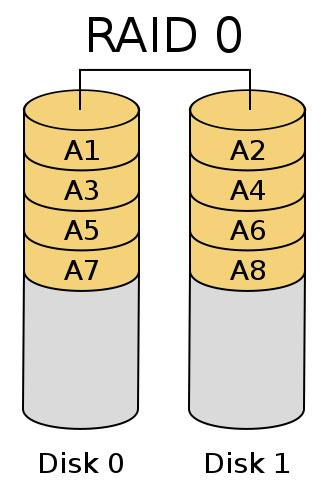
RAID 1 is the most basic form of RAID capable of ensuring data security. Just like RAID 0, RAID 1 requires a minimum of two hard disks to work. Data is written simultaneously to two identical drives (Mirroring). In the event that one drive fails, the other will function properly and the failed drive can be replaced without worrying about data loss.
RAID 1 is not the first choice for those who need high speed because the performance is not optimal. However, for network administrators or those who manage a lot of important information, a RAID 1 system is indispensable. The final capacity of a RAID 1 system is equal to the capacity of a single drive (for example, two 80GB drives connected in RAID 1 would create a single system with 80GB of disk space).
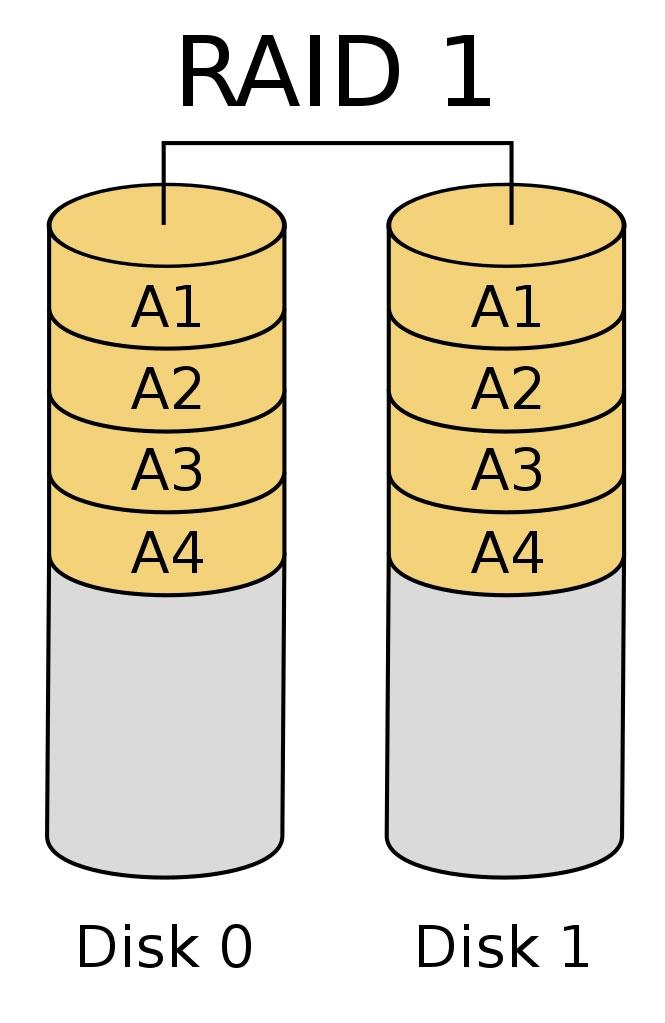
Have you ever imagined a storage system that is both as fast as RAID 0 and as safe as RAID 1 ? It is completely possible and not only you but also the desire of many others. The RAID 0+1 system was born to combine all the advantages of both systems.
However, the cost of owning such a system is quite expensive. You need at least 4 hard drives to run RAID 0+1 . Data will be simultaneously written to 4 hard drives with 2 accelerated Striping drives and 2 backup Mirroring drives. These drives must be identical, and when combined into a RAID 0+1 system , the final capacity will be half of the total capacity of those 4 drives.
For example, if you use four 80GB drives, the amount of "visible" data will be (4*80)/2 = 160GB.
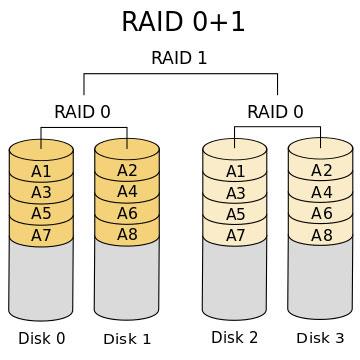
It can be understood that RAID 5 is an improved redundant storage system compared to RAID 1 and RAID 0 . With 3 or 5 separate hard disks, data and backups are evenly distributed across all hard drives. However, this principle is quite complicated. Example of 8 data segments (1-8) and 3 hard drives: data segments 1 and 2 are written to drives 1 and 2, backup segments are written to drives 3.
Fragments 3 and 4 are written to drives 1 and 3, with the backup segment writing to drive 2 respectively. Fragments 5 and 6 are written to drives 2 and 3, and the backup segment is written to drive 1. Then this sequence repeats with segments 7, 8 written to drive 1, 2 and the backup segment written to drive 3. Thus RAID 5 ensures improved speed and high safety. The final system capacity is equal to the total capacity of the hard disks minus one drive. For example, if you use three 80GB drives, the final capacity will be 160GB.
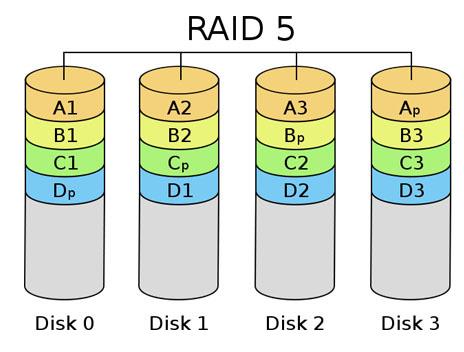
Although not a mainstream RAID type, JBOD (Just a Bunch Of Disks) still has some similar features and is supported by most RAID controllers. JBOD allows users to connect an arbitrary number of drives to their RAID controller (within port limits) and aggregate them into a larger hard disk for system use.
For example, if you connect 10GB, 20GB and 30GB drives, the computer will recognize a 60GB hard disk. However, JBOD does not provide any ancillary value, does not improve performance or ensure data safety, it simply connects and aggregates capacity.
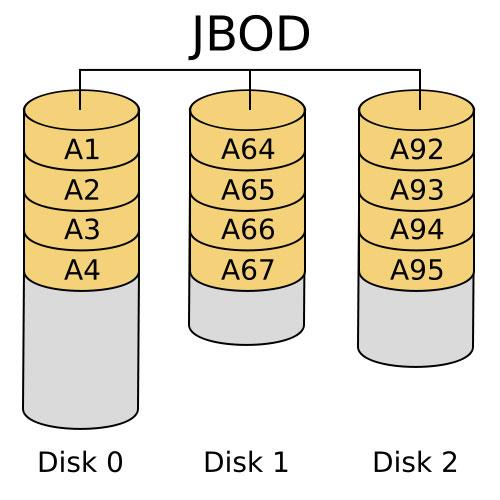
The RAID standards mentioned earlier are the most popular and widely used RAID standards. However, there are many other types of RAID that are applied in computer systems for separate purposes, including: RAID level 2 (Error-Correcting Coding), RAID level 3 (Bit-Interleaved Parity), RAID level 4. (Dedicated Parity Drive), RAID level 6 (Independent Data Disks with Double Parity), RAID level 10 (Stripe of Mirrors, as opposed to RAID 0+1), RAID level 7 (brand of Storage Computer Corporation, allowing more cache for RAID 3 and 4), RAID S (invented by EMC Corporation and used in their Symmetrix storage systems).
In addition, there are some other variants, such as Intel Matrix Storage which allows running RAID 0 + 1 with only 2 hard drives or RAID 1.5 of DFI on BMC 865, 875 systems. Although they have many differences. , but most are upgraded versions of traditional RAID methods.
Raid 10 is a RAID method that combines Raid 1 and Raid 0. Data is stored simultaneously on 4 hard drives, of which 2 are Striping (Raid 0) and 2 (Mirroring) Raid drives . Compared to Raid 5, Raid 10 also helps improve performance and data safety. However, Raid 5 is more cost-effective than Raid 10.
Raid 50 is the perfect combination of Raid 5 and Raid 0 . The data is first written according to Raid 0 mechanism and then divided according to Raid 5 mechanism on the second write. As a result, Raid 50 still ensures the same query speed as Raid 10, but uses much better hard drive space than Raid 10.
To be able to use RAID , it is necessary to have at least one controller card and two hard drives of the same capacity. Drives can use any standard such as ATA, Serial ATA or SCSI, but it is best to have them exactly the same to ensure optimal performance when operating in a synchronous mode such as RAID.
For example, if you combine a 160GB hard drive with a 40GB drive (whether it's RAID 0 or RAID 1) , the overall system performance is only equivalent to a pair of 40GB and 120GB hard drives that will be wasted. The right number of drives will depend on the type of RAID you plan to use. The drive's interface doesn't matter, but new BMCs can support both SATA and ATA. RAID cards can be onboard or discrete and they centralize the data cables that connect the hard disks in the RAID system , handling all the data that goes through it. If the BMC does not integrate RAID, you can buy a PCI controller card on the market for a cheap price. However, choosing to buy a BMC with integrated RAID is one of the solutions to improve system performance and ensure data safety.
Drive hot-swap trays are an optional component in a RAID system , but are sometimes very useful. They allow the failed drive to be replaced without shutting down the system (simply unlocking it, unplugging the drive and plugging in a new one). These trays are commonly used with SCSI hard drives and are especially important for server systems that need to be up and running continuously.
In terms of software, installing RAID on most modern operating systems is very simple, especially on Microsoft Windows. If using Windows XP, adding RAID is also very easy. Drivers are the most important, but if they are supplied with the device, installation will be simpler. If you have difficulty in installing RAID, refer to the following section of the article to find a solution.
When upgrading a system to RAID , there are two scenarios to consider. If the RAID system is used to store or exchange information at high speed, the installation is very simple. However, if you plan to use a RAID system to install the operating system or software, the installation process will be very complicated and must be done from scratch.
Once you've decided to take your system to the next level, you'll need to choose the right RAID model. You have a variety of RAID solutions to choose from, including RAID 0, 1, 0+1 and 5 . Among them, RAID 0 and 1 are the most economical solutions and are commonly used on most current BMC series. However, RAID 0+1 and 5 models are usually only used on high-end, expensive models.
RAID 0 has the highest data transfer rate, but is also the most fragile type of RAID . For example, if you use 4 hard disks in RAID 0, the data transfer speed can go up to more than 100MB/s - a very attractive number for any PC user.
However, the possibility of data loss also increases 4 times, because the computer hard disk is a moving product and will be "aging" gradually after a period of use. In addition, mains failure or control failure can also lead to data loss. Therefore, RAID 0 is not suitable for long-term data storage, but it is a good solution for temporary drives that need high speed, such as web database storage. If you plan to use RAID 0 for the long term, you should add a few more hard drives and switch to a RAID 0+1 system, which is ideal if you have a large budget.
Using RAID 1 alone has no effect other than creating a new drive identical to the main drive. Usually, users do not care about RAID 1 if they only store and manage normal documents. However, for those who need to store and manage important information such as the server that stores customer or account information, RAID 1 becomes a useful choice. If using RAID 1 , consider adding a hot-swap tray for faster data recovery by dismounting drives and cloning to a new drive while the system is running.
For RAID systems built with 4 or more hard disks, RAID 5 is the first choice because of its ability to combine error correction and acceleration. If you are planning to build a RAID system, RAID 5 is definitely the optimal solution.
RAID combinations, such as RAID 0+1 or RAID 50 (5+0) , often combine the characteristics of the basic RAID forms. However, you need to consider before using it because the cost of components is quite high. Below is a summary table for you to choose the right RAID type for your use:

First, to choose the right components, you need to pay attention to the RAID controller chipset . Usually, you won't have much choice because these chipsets are usually integrated on the BMC. However, you need to pay attention to the following points.
Currently, there are two types of RAID controllers in common use, the controller chip integrated on the chipset or external.
The integrated control chipset includes:
- Intel ICH5R, ICH6, ICH7 along with i865/875/915/925/945/955 series
- nVIDIA nForce2-RAID (AMD), nForce 3 Series (AMD A64), nForce 4 Series (AMD A64/ Intel 775)
These types are generally low latency and easy to use. However, they have limited features and limited software. Using external control chips from manufacturers such as Promise Technology, Silicon Image, Adaptec, the software and features are somewhat richer and use minimal resources, but the latency is often higher (not significant) ). The removable cards are easy to change and disassemble when necessary. Note, Silicon Image Sil3112 has relatively poor compatibility, so when switching to other RAID systems, data may be lost. Sil3114 and higher have fixed this error. nForce and ICH5,6,7 systems can swap hard drives back and forth easily, their BIOS RAID is also smarter, and often has the ability to recognize groups of preformatted RAID hard drives.
The latest BMCs, such as the DFI Lanparty NF4 SLI-DR , support both RAID 5 . In terms of desktop interfaces, there are usually only PATA or SATA types, and SATA is the wiser choice because it doesn't need to use a lot of cables, and there are many technological improvements in speed and performance. If you have enough money, you can consider professional products that allow you to plug in more RAM to use as a huge cache to increase speed significantly.
For hard drives, it is advisable to choose types capable of large data transfer and fast access speed. Access Time (Access Time) is as small as possible, specifying the time it takes for the hard disk to find the data it needs. In addition, it is advisable to choose a hard drive with a large cache (8MB or more), and technologies such as Seagate NCQ can significantly increase performance. It is best to choose the same hard drives to avoid affecting the performance of the RAID.
The RAID installation is simple and mainly relies on the BIOS of the motherboard and the RAID controller. After plugging the hard drive into the onboard RAID location (see product documentation for details), simply go into the BMC's BIOS to enable the RAID controller and specify the relevant ports (usually in the Integrated section). Peripherals).
After saving the parameters and restarting the computer, you need to pay attention to the notification screen and press the correct key combination when the computer asks (eg Ctrl+F or F4) to enter BIOS RAID.
Although each RAID type has a different interface, the following basic operations are always necessary:
- Specify the hard drive to join the RAID.
- RAID type selection (0/1/0+1/5).
- Specify Block Size: This parameter affects the performance of RAID. If the Block Size is set not suitable for use, it will waste memory and reduce performance. For example, if the Block Size is 64KB, then at least 64KB will be written to the drive in all cases, even if it is a text file that is only 2KB in size. Therefore, this value should approximate the average size of the files used. If the hard drive contains many small files, such as Word documents, you should keep the Block Size small. If the hard drive contains a lot of movies or music, a large Block Size will give better performance (especially with RAID 0 systems).
In addition to deciding where to store files, Block Size has another function. For example, if the Block Size is 64KB and the file size is less than 64KB, the file will only be stored on one drive in the RAID system, with no performance improvement. However, if the file size is 150KB, it will be split into 3 chunks 64KB + 64KB + 22KB and stored on 3 different drives, significantly increasing performance because the controller can read information from the drives. simultaneously. If Block Size is 128KB, that file will only be stored on 2 drives, 1 28KB + 22KB . If there is no special need, it is recommended to choose Block Size of 128KB for desktop computers.
Once the controller has recognized the new hard drive, you can install the operating system and format the RAID drive. Installing Windows is the same as usual, however, you need to prepare a floppy drive and floppy disk containing the drivers for the RAID controller. When entering the installation, you need to pay attention to the text at the bottom of the screen to press F6 in time, then wait and when asked, press S to add the RAID driver to the installation.
Once you have completed the installation of the RAID system , the next steps are the same as the installation on a normal hard drive.
Once the system is stable, you need to install additional RAID system control utilities to take advantage of extended features and sometimes even performance. Some typical programs can be mentioned as Intel Application Acceleration RAID Edition or nVIDIA RAID Manager...
Note:
If you want to set up RAID 0 on a drive that contains data, you must back up the data and reformat the drive. Therefore, choose a suitable backup plan before doing so. For RAID 1 systems, data backup is not required.
When using a RAID 0 system , you should have a small drive to store the most important files to avoid data loss when something goes wrong.
When restarting the computer, especially when the computer is booting up abnormally, the RAID controller's hard drive recognition process may take longer than usual, and strange noises may occur. from the mechanical part of the hard disk. This is completely normal because the controller must synchronize the operation of all the drives in the RAID group it manages.
RAID groups of hard disks usually consist of several hard drives operating side by side, so the heat generated is quite large, which is not beneficial in the long run. If possible, you should find a heat dissipation solution to avoid unintended problems.
After going through the items listed above, probably everyone has a good understanding of the concept of RAID . However, in order to use RAID correctly and safely, as well as handle RAID-related problems, users need to know some more information.
Often when using RAID, users often only use 2 hard drives and think that it is safe. But have you thought about what to do when one of the hard drives fails? You can search for a replacement hard drive of the same type and serial number, but this can be difficult and time consuming. Moreover, using two non-similar hard drives will make the system not perform optimally, even RAID cannot be set up.
So a safe solution when using RAID is to use Hot Spare. What is Hot Spare? It is used as a fallback mechanism to ensure system stability. When a system component fails, Hot Spare automatically replaces that component. When set to this mode, if one of the two hard drives dies, the other hard drive will automatically replace and recreate the RAID system automatically, helping you to avoid data loss and ensure stability. of the system.
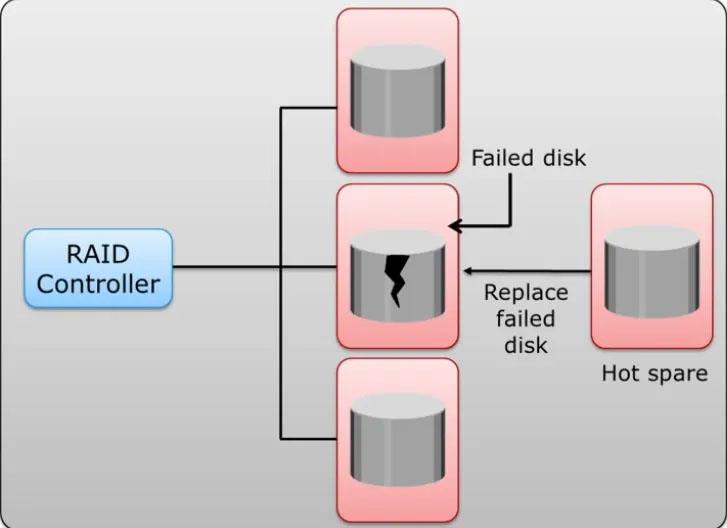
Intel Serial IO Driver plays an important role in connecting software between devices and operating systems on your PC, MAC or Tablet. This driver monitors and controls communication between applications and interfaces provided by device accessories as they are attached to your system. Without this driver, RAID will not work and cannot be accessed or used.
In the field of data storage, data striping is a method of sequentially storing data on many different physical disks, the purpose of which is to speed up data access. It works by dividing the bits of each byte in order and storing them on different disks, creating a persistent data storage file similar to a single file.
Intel's IRST (Intel Rapid Storage Technology) is a new solution for efficient hard drive management, protecting your data from loss in the event of a partial hard drive failure, saving energy, and increasing speed. data access. With the production of a lot of digital content such as videos, images and documents, the amount of production data is increasing every day, requiring a secure and reliable storage solution. IRST has been integrated on popular Windows operating system platforms such as Windows 7, 8, 8.1 and Windows 10.
It can be affirmed that the value that RAID brings to the system is undeniable. RAID 0 and 0+1 are most commonly used in home environments. Although RAID 0 provides the fastest performance, it is also dangerous. A system failure can cause total data loss. Meanwhile, RAID 1 provides the highest level of information security, but leads to a sense of waste for users because performance and capacity only reach 50%. RAID 5provides high performance and safety, but requires expensive control equipment and the cost of the drive is also higher. Some users switch to SCSI drives for high performance and safety, however, the cost of a good SCSI system can be even more expensive.
In addition, the IDE standard also has many problems, for example the drives are not designed to run continuously and the ATA cables are too cumbersome, leading to crowded cases and increased heat generation. However, with the development of technology and the emergence of new standards such as SATA , RAID will continue to evolve and become the ideal choice for high-end computer systems.
How to pin comments on TikTok, TikTok allows users to pin comments easily. Here's how to pin comments on TikTok videos.
Instructions for Organizing a Q&A session on Facebook, Recently, Facebook has launched the feature to create a Q&A session, when you post a question for everyone to answer.
Instructions for installing and recording videos with Likee, Likee is an application that supports extremely beautiful and impressive video recording, and is loved by many young people today. The following,
How to export the list of meeting participants in Zoom, How to take attendance on Zoom is not difficult, it even allows you to export the list of students participating in the class.
How to change font on Xiaomi, Want to create a new image for Xiaomi device? Just follow the instructions below to change the font style and size above
Instructions for creating a mirror image effect on Picsart, Picsart is an application where users only need to perform a few simple steps to transform the photo.
How to add new fonts to Microsoft Word, Can't find the font you want to use for documents in Microsoft Word? Don't worry, you can install new fonts for Word according to these steps
How to turn off the computer screen and still have the computer running, How to turn off the PC screen and still have the computer running on Win 10/11? Very simple. Here's how to turn off the computer screen
To fix the “An unexpected error occurred” issue when logging in to Facebook, you can try the following steps
Users reported that their Facebook, Messenger and Instagram accounts were suddenly logged out and could not be accessed again, both on the app and web version.
Instructions on how to take photos on Tiktok are extremely simple. Tiktok is a famous application for recording and creating short videos on social networks. However, this application also
How to find and get Instagram links, Instagram is one of the most popular and easy-to-use social networking platforms today. However, because it is designed specifically for mobile,
Instructions for locking the mouse cursor when playing games on BlueStacks, Instructions for turning on/off the mouse cursor lock feature when playing games in the BlueStacks App Player emulator.
Instructions for installing and using Faceapp using an emulator on PC, Simple and easy instructions on how to install and use the Faceapp face editing app using an emulator on PC
Instructions for creating a cover photo group on Facebook, Creating a cover photo group is a feature that helps users set Facebook cover photos with many different images (maximum of 6 photos).
Learn how to effectively use the Stochastic Indicator for technical analysis on Bubinga. Explore advanced techniques to enhance your trading strategies
Instructions for adding angel wings to photos using PicsArt, PicsArt is a photo editing application used by many people today. Today WebTech360 will introduce the article
How to turn off the Just accessed notification on Zalo. This article WebTech360 will guide you to turn off the Just accessed notification under your Zalo chat name.
Instructions for blocking and unblocking accounts on TikTok. Similar to other social networking applications, TikTok also allows users to block someone's account
How to write a long status with a colorful background on Facebook, Today, WebTech360 will introduce some steps to post a long status with a colorful background on Facebook,

